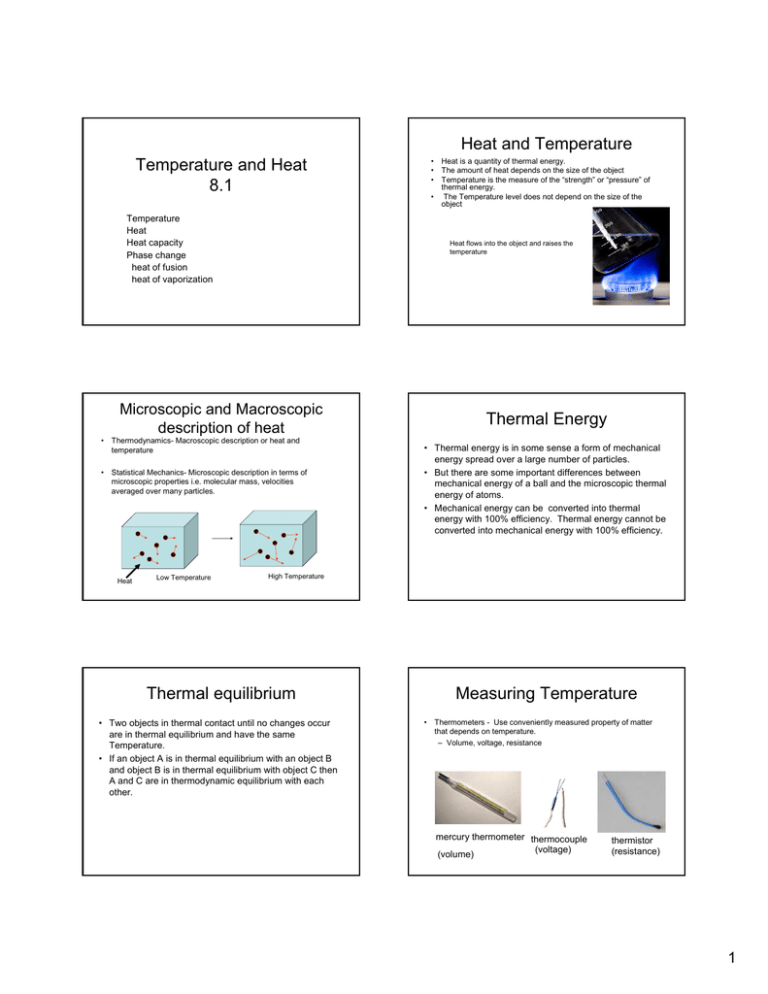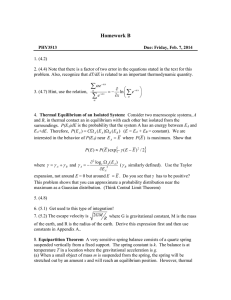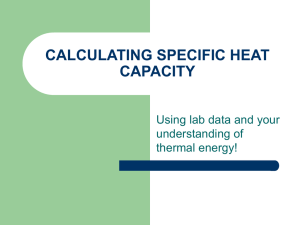Heat and Temperature Temperature and Heat 8.1
advertisement

Heat and Temperature Temperature and Heat 8.1 Temperature Heat Heat capacity Phase change heat of fusion heat of vaporization Heat flows into the object and raises the temperature Microscopic and Macroscopic description of heat • Thermodynamics- Macroscopic description or heat and temperature • Statistical Mechanics- Microscopic description in terms of microscopic properties i.e. molecular mass, velocities averaged over many particles. Heat Low Temperature • Heat is a quantity of thermal energy. • The amount of heat depends on the size of the object • Temperature is the measure of the “strength” or “pressure” of thermal energy. • The Temperature level does not depend on the size of the object Thermal Energy • Thermal energy is in some sense a form of mechanical energy spread over a large number of particles. • But there are some important differences between mechanical energy of a ball and the microscopic thermal energy of atoms. • Mechanical energy can be converted into thermal energy with 100% efficiency. Thermal energy cannot be converted into mechanical energy with 100% efficiency. High Temperature Thermal equilibrium • Two objects in thermal contact until no changes occur are in thermal equilibrium and have the same Temperature. • If an object A is in thermal equilibrium with an object B and object B is in thermal equilibrium with object C then A and C are in thermodynamic equilibrium with each other. Measuring Temperature • Thermometers - Use conveniently measured property of matter that depends on temperature. – Volume, voltage, resistance mercury thermometer thermocouple (voltage) (volume) thermistor (resistance) 1 Gas Thermometer Celsius Temperature scale Gas thermometer – Fundamental definition of temperature in terms of the pressure of a ideal gas. Temperature (oC) Boiling point of water x 100 x T 0 Temperature T Freezing point of water x Pressure Fahrenheit Temperature scale Kelvin scale x Boiling point of water Temperature (oF) x T 32 Boiling point of water Temperature T x Freezing point of water Pressure Temperature scale conversion Celsius to Kelvin x Temperature (K) x 212 273.16 K Triple point of water (solid liquid and gas present at equilibrium) Absolute Zero 0K x 0 Pressure Question A swine flu patient has a temperature of 40o C. Find his temperature in Kelvin and Celsius. TK = TC + 273.16 Celsius to Fahrenheit 9 TF = TC + 32 5 2 Heat and temperature Temperature of physical processes Heat , Q is thermal energy needed to raise the temperature of an object. Units of Heat Joules Heat has units of energy, Calories (cal) Nuclear fusion Temperature Deuterium-Tritium Joules ∆T One calorie is the heat required to raise the temperature of one gram of water 1 degree C. 1cal= 4.184 J ∆Q Room Temperature British Thermal Units BTU. On BTU is the heat required to raise the temperature of one pound of water on degree Fahrenheit 1BTU =1055 J Heat Capacity and specific heat Heat capacity- C – ratio of heat input to temperature rise in heating an object. ∆Q = C ∆T ∆T the heat capacity depends on the size of the object. Specific Heat –c- Heat capacity divided by the mass ∆Q ∆Q = mc ∆T the specific heat is independent of the size of the object but only depends on the material out of which the object is made. Specific heats Substance SI J/kgK cal/goC Aluminum 900 0.215 Copper 386 0.0923 Iron 447 0.107 glass 753 0.18 Water 4184 1.00 Ice(-10oC) 2050 0.49 Wood 1400 0.33 Question The energy content of food is given in kilocalories C. A glass of beer has a energy content of 150 C. If this beer is drunk by a 75 kg UCSD student during the Sun God festival what would be the temperature rise assuming all the energy was converted to heat and the student’s heat capacity was that of water. Question You want to heat up your coffee (240 ml) of coffee in a microwave oven. If 1000 W of power is absorbed by the coffee how long does it take to raise the temperature from 20o C to the boiling point. Ignore the heat capacity of the cup. Heat to raise the temperature ∆Q = mc ∆T Heat output from the oven ∆Q = P ∆ t ∆t = mc ∆T P = (0.24kg )(4184J / kg oC )(100 − 20o C ) = 80s 1000J / s 3 Phase change Heat of transformation Heat can provide thermal energy to change the phase of a material. The energy is required to break interactions between atoms. • Fusion – Change from solid to liquid • Vaporization – Change from liquid to gas • Sublimation- Change from solid to gas. Latent Heat of transformation Substance Lf (kJ/kg) • Latent heat of fusion (solid to liquid) Q = Lf m • Latent heat of vaporization (liquid to gas) Q = Lv m Phase change in water Lv (kJ/kg) Water 334 2257 Alcohol 109 879 Copper 205 4726 Mercury 11.3 296 Ice Question 0o A 200 g mass of ice at C is in a microwave oven with 1000 W of power. Assume all the power goes into heating the ice. How long will it take to melt? How long will it take to go from the melting point to the boiling Heat input At the melting temperature and boiling temperature, two phases are In equilibrium and the heat does not cause a change in temperature. The relative amounts of the two phases changes. Question A 250 ml cup of coffee is at 80oC. What amount of ice would have to be added to bring the coffee to 5oC assuming no heat flows out of the cup point? How long will it take to evaporate completely? Melting Temperature rise Evaporation ∆t = Q mLf = p p ∆t = Q mc ∆T = p p ∆t = mLf p = (0.2)334 x103 = 66s 1000 = Q (0.2)(4184)(100) = 84s 1000 = 0.2(2257 x103 ) = 450s 1000 4







